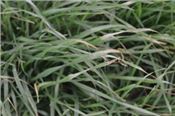|
Sugarcane, Wheat Crops Withstand Freeze

Wheat plants show tip burn on leafs seven days after below-freezing temperatures.
Photo by Boyd Padgett/LSU AgCenter
BATON ROUGE, LA.
Louisiana farmers and experts are remaining “cautiously optimistic” that the recent freezing weather did not significantly damage the state’s sugarcane or wheat crops.
Most of the state’s sugarcane mills completed their grinding season at the end of the year before the cold weather arrived. Some mills in the Bayou Teche area in Iberia and St. Mary parishes are expected to go into the middle of January before finishing.
Blair Hebert, LSU AgCenter agent in Iberia Parish, indicated around 10 percent of the area’s crop was still left to be harvested. He said one reason for the mills running this late is an increase in sugarcane acres.
“As cane acres increased to the north and west of the Teche, a lot of that cane is coming to the Teche-area mills because they are the closest ones,” Hebert said.
Mark Patout farms 3,000 acres of sugarcane in Iberia and St. Mary parishes. He believes there are two more reasons for the late finish – a large crop and a late start.
“We’ve had a good crop,” Patout said. “We didn’t start as early as we wanted to, and those two factors right there got us into the position where this freeze might affect us more than most years.”
A hard freeze can cause the stalks to split, allowing bacteria to get into the stalks and reduce the sugar content. This deterioration can be accelerated if warmer weather occurs shortly after the freeze, he said.
AgCenter sugarcane specialist Kenneth Gravois said the weather after the freeze is critical to how the crop responds. So far, the weather has cooperated.
“We’ve had continual cool weather, cool days and cool nights,” Gravois said. “And another important factor is we stayed dry right after the freeze, so there’s less mud to bring to the factory.”
Unfortunately, rain is expected to return by the beginning of next week, but temperatures are still expected to be favorable.
Farmers and mills are making a coordinated effort to ensure that everyone’s crop makes it to the mill and is processed, Patout said.
“It’s neighbor helping neighbor,” he said.
The Louisiana wheat crop will likely escape unharmed from the recent freeze. Some areas of the state saw temperatures as low as the upper teens, which could severely damage wheat later in the season.
AgCenter wheat specialist and central region director Boyd Padgett said the young crop isn’t so vulnerable to the cold.
“The growing point is below the ground, which makes it tolerant to below-freezing temperatures for several hours,” Padgett said.
When the first joint or node emerges from the ground, the wheat becomes more susceptible to freezing temperatures, he said.
“I am not aware of any wheat jointing right now,” Padgett said.
The specialist said growers could expect to see superficial injury such as leaf burning in the next seven days. The wheat can recover from this injury with no significant effect on yields.
Oat varieties are more susceptible than wheat to the cold, but the crop also is still in the juvenile growth stage with vulnerable growing points below the soil surface, Padgett said. ∆
|
|